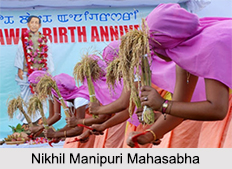 Nikhil Manipuri Mahasabha or NMHM was first started as a Hindu nationalist organization founded in Manipur in 1934. Nikhil Manipuri Mahasabha was opposed to the rising Manipuri nationalism, and required to protect the welfare of Hindus in the state. The organization was modeled after the Akhil Bharatiya Hindu Mahasabha.
Nikhil Manipuri Mahasabha or NMHM was first started as a Hindu nationalist organization founded in Manipur in 1934. Nikhil Manipuri Mahasabha was opposed to the rising Manipuri nationalism, and required to protect the welfare of Hindus in the state. The organization was modeled after the Akhil Bharatiya Hindu Mahasabha.
The brief of Nikhil Manipuri Mahasabha are as follows -
• 1st Session, Nikhil Manipuri Hindu Mahasabha, Imphal, 1934 - This organization was originally known as the Nikhil Manipuri Hindu Mahasabha and was founded under the patronage of Maharaja Churachand Singh who was the president of the organization. Hijam Irabot who was the vice-president carried out all the organizational works.
• 2nd Session, Nikhil Manipuri Hindu Mahasabha, Tarepur - The second session was held at Tarepur in Silchar.
• 3rd Session, Nikhil Manipuri Hindu Mahasabha was held at Mandalay in Burma.
• 4th Session, Nikhil Manipuri Hindu Mahasabha was held at Chinga in 1938
However, the Nikhil Manipuri Hindu Mahasabha at the fourth session was held at Chinga in Manipur, where Maharaja Churachand did not attend the session. Irabot changed the name of the Sabha by erasing the Hindu off the original name. He also changed it into a political party. Maharaja Churachand did not however like this kind of activities and sent a warning to Irabot on the events taking place in his absence. A section of the Nikhil Manipuri Mahasabha split to join the second Nupilal. They called themselves the Praja Sanmelani, which was recognized on 7 January 1940. During the Second World War, many Nikhil Manipuri Hindu Mahasabha leaders joined the Indian National Army and they took a minor role in the Battle of Imphal.



















